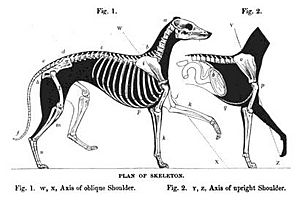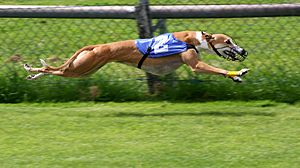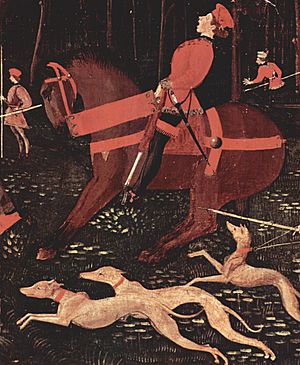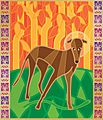Greyhound facts for kids
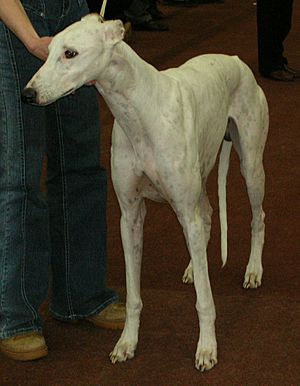 |
||||||||||||||||||||||||||
| Other names | English Greyhound | |||||||||||||||||||||||||
|---|---|---|---|---|---|---|---|---|---|---|---|---|---|---|---|---|---|---|---|---|---|---|---|---|---|---|
| Origin | Europe/Eurasia | |||||||||||||||||||||||||
|
||||||||||||||||||||||||||
|
||||||||||||||||||||||||||
| Domestic dog (Canis lupus familiaris) | ||||||||||||||||||||||||||
A Greyhound is a dog breed known for being very fast. They are skinny and have long legs. In fact, they can run faster than any other dog breed! Greyhounds are also one of the oldest dog breeds around.
For hundreds of years, people have raced Greyhounds in some parts of the world. Greyhound racing is quite similar to horse racing. Sadly, some Greyhounds have been treated badly or even killed after they get too old to race. But many animal rights groups work hard to rescue these dogs. They help them find new homes as pets, where they can live happy lives.
Contents
Discover the Greyhound Dog Breed
What Greyhounds Look Like
Male Greyhounds are usually about 71 to 76 centimetres (28 to 30 in) tall at the shoulder. They weigh around 27 to 40 kilograms (60 to 88 lb). Females are a bit smaller. Their shoulders are typically 68 to 71 centimetres (27 to 28 in) high, and they weigh less than 27 to 34 kilograms (60 to 75 lb).
Greyhounds have very short hair, which is easy to keep clean. They come in about thirty different colors! You might see them in white, brindle (striped), fawn (light brown), black, red, or blue (gray). These colors can be solid or mixed together. Greyhounds also have a long, narrow head and snout.
How Greyhounds Are Built for Speed
A Greyhound's amazing speed comes from its body. They are light but very muscular. They have the largest heart and the most fast-twitch muscle fibers of any dog breed. Their flexible spine allows them to stretch out fully when they run.
When a Greyhound runs its fastest, it uses a special way of moving called a "double suspension gallop." This means all four of their feet are off the ground twice during each stride. First, their legs are tucked under them, and then they stretch out completely.
Greyhound Temperament and Personality
Some people think Greyhounds are aggressive because they wear muzzles during races. But this is not true! Muzzles are worn to stop dogs from accidentally nipping each other during or after a race. Their thin skin can tear easily, so even a small bite can cause an injury.
Greyhounds are usually very gentle dogs. They are bred for short bursts of speed, not for running long distances. This means adult Greyhounds do not need hours of exercise every day. However, young Greyhound puppies can be very energetic. They need more playtime and training to learn how to use their energy.
Greyhounds as Loving Pets
Many Greyhound owners and rescue groups say that Greyhounds make wonderful pets. They are quiet, gentle, and very loyal to their families. Greyhounds are loving dogs who enjoy being with people and other dogs.
Whether a Greyhound gets along with smaller animals like cats depends on the individual dog. Some Greyhounds have a strong urge to chase small prey. But many can live happily with toy dog breeds or cats. Owners often call retired racing Greyhounds "45 mile per hour couch potatoes." This means they love to run fast but also enjoy relaxing a lot!
Greyhounds are happiest in calm homes. They do well with children if the kids learn to treat them kindly and with respect. Greyhounds are sensitive, so gentle training methods work best.
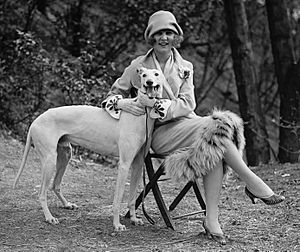
These dogs are "pack-oriented," meaning they quickly see their human family as their pack leaders. Sometimes, Greyhounds can get separation anxiety if they are left alone for too long. Getting a second Greyhound often helps with this problem.
Greyhounds usually do not bark much, which is great for living in neighborhoods. They are also often friendly to strangers. Many people think Greyhounds are hyperactive, but this is usually not true for retired racers. They can live comfortably in apartments because they do not need a lot of space. They also sleep for about 18 hours a day! In fact, their calm nature can make them better apartment dogs than some smaller, more active breeds.
At some racetracks, Greyhounds live in crates for most of the day. Because of this, they are usually very easy to crate train in a home.
Many groups that help adopt Greyhounds suggest keeping them on a leash when outdoors. This is because of their speed and their natural urge to chase. They also might not be aware of dangers like cars. However, it is important for Greyhounds, especially younger ones, to have a good run at least once a week in a safe, enclosed area. Adoption groups also recommend fences that are 4 to 6 feet tall to keep them from jumping out.
Roles of the Greyhound Breed
Greyhounds and Coursing
Originally, Greyhounds were used for hunting deer in the British Isles and Europe. Later, they became famous for hunting hares in a sport called hare coursing. Some Greyhounds are still used for coursing today. However, sports like lure coursing (where dogs chase an artificial lure) and racing are much more common.
Greyhound Racing History
Until the early 1900s, Greyhounds were mainly bred for hunting and coursing. In the 1920s, modern Greyhound racing began in the United States and England. It also started in Northern Ireland and the Republic of Ireland. The Greyhound holds the record for being the fastest dog ever recorded.
Besides professional racing, many Greyhounds also do well in amateur races. Groups like the Large Gazehound Racing Association (LGRA) and the National Oval Track Racing Association (NOTRA) let Greyhounds and other sighthound breeds compete in fun racing events across the United States.
Greyhounds as Companions
For a long time, Greyhounds have been seen as elegant and noble companions in art and stories. They were known as the best hunting dogs. Today, many Greyhounds from the racing industry are adopted as pets after they retire. This has made them known as friendly companions.
Outside of racing, some people also show Greyhounds in dog shows. They are also popular as family pets. In recent years, there has been a decrease in betting at racetracks. This has led to some tracks closing in the US. This means more Greyhounds need loving homes after their racing careers end.
The History of Greyhounds
Some stories say Greyhounds came from Ancient Egypt. Pictures of slim, smooth-coated dogs like salukis have been found there from around 2000 BC. However, DNA studies from 2004 suggest that Greyhounds are not closely related to those breeds. Instead, they are closer to herding dogs.
The first sighthounds in Europe were likely brought by the ancient Celts from Eastern Europe or Eurasia. All modern Greyhounds come from dogs first recorded in special books in the 1700s and 1800s in the United Kingdom. These records were later used by racing and kennel clubs.
Historically, these sighthounds were used for hunting in open areas. Their excellent eyesight was very helpful. It is thought that Greyhounds were brought to what is now the United Kingdom around 5th and 6th century BC by Celtic people. However, some people in Scotland, like the Picts, may have had large hounds similar to the deerhound even before 6th century BC.
The name "Greyhound" probably comes from the Old English word grighund. "Hund" means "hound," but the meaning of "grig" is not fully known. It does not seem to be related to the color "grey." Greyhounds actually come in many different coat colors. In medieval England, people who owned Greyhounds for sport wanted them to be bred in colors that were easier to see while hunting. This is how lighter colors, patches, and white markings appeared in the breed.
The Greyhound is the only dog mentioned by name in the Bible. In some versions, like the King James Version, the Greyhound is named as one of the "four things stately" in the Book of Proverbs.
In 1928, the very first winner of "Best in Show" at the famous Crufts dog show was a Greyhound named Primeley Sceptre. It was owned by H. Whitley.
Related Pages
Images for kids
See also
 In Spanish: Galgo inglés para niños
In Spanish: Galgo inglés para niños


